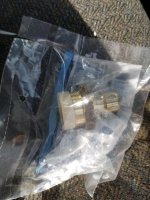Hello everyone. I am remodeling my jetted tub/shower down to the studs. I currently have 15 year old 1/2 CPVC pipes.
I will be installing a 2.5 gpm shower head with a 2.5 gpm shower wand to a Delta 3-way multi valve. The shower valve is supposed to be rated at 5.3 gpm at 40 psi, 6.5 gpm at 60 psi and 7.4 gpm at 80 psi. I currently don't know what my current actual specs are but the water flow and pressure seems pretty nice.
I am going to have to reroute the water lines since the builder has the water supply going from the wall to a roman style tub faucet. The lines are then T'd off at the faucet. The cold has three 90's zig zag around the tub with another 90 degree to run the wall. The hot only has two 90's. Then both supply lines hits another 90 to connect to the valve.
I would like to operate the shower wand and shower head at the same time so I was thinking of installing PEX A. so the flow wouldn't decrease to terribly much compared to the crimp fixtures of PEX B. I will be (should be) doing the install myself. All the 1/2 fittings are readily more available than the 3/4 fittings. I can order all the 1/2 parts from one brand and from one location, but with the 3/4 I will have to order things from a few locations, especially the 3/4 PEX A to 1/2 drop elbow. The difference in price isn't a deciding factor since this is a remodel and the difference is small since the distance is only like 5 ft per line.
The wall the shower and the pipes will be on is a non structural interior wall bumped out from the actual exterior wall. I can enough room, I can probably have the PEX tubing to directly from the floor CPVC adapter to the valves with no other fittings.
Couple of questions. Should I install 1/2 or 3/4 PEX A from the CPVC supply lines to the valves to keep a flow loss at a minimum especially since the inner diameter of 1/2 PEX is much less than the inner diameter of CPVC? Then which should I use to the shower head and shower wand drop elbow fixture? 1/2 or 3/4? Or would it make more sense having the supply to the valve be 3/4 and then from the head and wand be 1/2? don't want to have buyers remorse since it's a one and done situation.
Or should I just replace it with new CPVC pipes? Nobody seems to really recommends CPVC pipes anymore. Also the pipes will in inaccessible when the project is done. If i missed something, please let me know.
Thanks
I will be installing a 2.5 gpm shower head with a 2.5 gpm shower wand to a Delta 3-way multi valve. The shower valve is supposed to be rated at 5.3 gpm at 40 psi, 6.5 gpm at 60 psi and 7.4 gpm at 80 psi. I currently don't know what my current actual specs are but the water flow and pressure seems pretty nice.
I am going to have to reroute the water lines since the builder has the water supply going from the wall to a roman style tub faucet. The lines are then T'd off at the faucet. The cold has three 90's zig zag around the tub with another 90 degree to run the wall. The hot only has two 90's. Then both supply lines hits another 90 to connect to the valve.
I would like to operate the shower wand and shower head at the same time so I was thinking of installing PEX A. so the flow wouldn't decrease to terribly much compared to the crimp fixtures of PEX B. I will be (should be) doing the install myself. All the 1/2 fittings are readily more available than the 3/4 fittings. I can order all the 1/2 parts from one brand and from one location, but with the 3/4 I will have to order things from a few locations, especially the 3/4 PEX A to 1/2 drop elbow. The difference in price isn't a deciding factor since this is a remodel and the difference is small since the distance is only like 5 ft per line.
The wall the shower and the pipes will be on is a non structural interior wall bumped out from the actual exterior wall. I can enough room, I can probably have the PEX tubing to directly from the floor CPVC adapter to the valves with no other fittings.
Couple of questions. Should I install 1/2 or 3/4 PEX A from the CPVC supply lines to the valves to keep a flow loss at a minimum especially since the inner diameter of 1/2 PEX is much less than the inner diameter of CPVC? Then which should I use to the shower head and shower wand drop elbow fixture? 1/2 or 3/4? Or would it make more sense having the supply to the valve be 3/4 and then from the head and wand be 1/2? don't want to have buyers remorse since it's a one and done situation.
Or should I just replace it with new CPVC pipes? Nobody seems to really recommends CPVC pipes anymore. Also the pipes will in inaccessible when the project is done. If i missed something, please let me know.
Thanks

